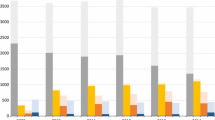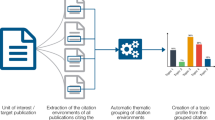Abstract
The aim of this paper is to identify the research status quo on pervasive and ubiquitous computing via scientometric analysis. Information visualization and knowledge domain visualization techniques were adopted to determine how the study of pervasive and ubiquitous computing has evolved. A total of 5,914 papers published between 1995 and 2009 were retrieved from the Web of Science with a topic search of pervasive or ubiquitous computing. CiteSpace is a java application for analyzing and visualizing a wide range of networks from bibliographic data. By use of it, we generated the subject category network to identify the leading research fields, the research power network to find out the most productive countries and institutes, the journal co-citation map to identify the distribution of core journals, the author co-citation map to identify key scholars and their co-citation patterns, the document co-citation network to reveal the ground-breaking literature and detect the co-citation clusters on pervasive and ubiquitous computing, and depicted the hybrid network of keywords and noun phrases to explore research foci on pervasive and ubiquitous computing over the entire span 1995–2009.










Similar content being viewed by others
References
Abowd, G. D., Dey, A. K., Brown, P., Davies, N., Smith, M., & Steggles, P. (1999). Towards a better understanding of context and context-awareness. Lecture Notes in Computer Science, 1707, 304–307.
Abowd, G. D., Harvel, L. D., & Brotherton, J. A. (2000). Building a digital library of captured educational experiences. Kyoto International Conference on Digital Libraries, 395–402.
Abowd, G. D., & Mynatt, E. D. (2000). Charting past, present and future research in ubiquitous computing. ACM Transactions on Computer–Human Interaction, 7(1), 29–58.
Chen, C. M. (2006). CiteSpace II: Detecting and visualizing emerging trends and transient patterns in scientific literature. Journal of the American Society for Information Science and Technology, 57, 359–377.
Chen, C. M., Ibekwe-SanJuan, F., & Hou, J. H. (2010). The structure and dynamics of co-citation clusters: A multiple perspective co-citation analysis. Journal of the American Society for Information Science and Technology, 61(7), 1–33.
Chen, C. M., Paul, R. J., & O’Keefe, B. (2000). Fitting the jigsaw of citation: information visualization in domain analysis. Journal of the American Society for Information Science and Technology, 52(4), 315–330.
Christiansen, B. O., Cappello, P., Ionescu, M. F., et al. (1997). Javelin: Internet-based parallel computing using java. Concurrency-Practice and Experience, 9(11), 1139–1160.
Dey, A. K. (2001). Understanding and using context. Personal and Ubiquitous Computing, 5, 4–7.
Dey, A. K., Abowd, G. D., & Salber, D. (2001). A conceptual framework and a toolkit for supporting rapid prototyping of context-aware applications. Human–Computer Interactions Journal, 16(2–4), 97–166.
Finin, T., Joshi, A., Kagal, L., Ratsimore, O., Korolev, V., & Chen, H. (2001). Information agents for mobile and embedded devices. Lecture Notes in Computer Science, 2182, 264–286.
Foster, I., Kesselman, C., & Tuecke, S. T. (2001). The anatomy of the grid. International Journal of High Performance Computing Applications, 15(3), 200–222.
Garfield, E. (1998). Mapping the world of science. In Proceedings of the 150 anniversary meeting of the AAAS (pp. 1–19), Philadelphia, PA.
Garlan, D., Siewiorek, D. P., Smailagic, A., & Steenkiste, P. (2002). Project Aura: toward distraction-free pervasive computing. IEEE Pervasive Computing, 1(2), 22–31.
Hjørland, B., & Albrechtsen, H. (1995). Toward a new horizon in information science: domain analysis. Journal of the American Society for Information Science and Technology, 46(6), 400–425.
Leonhardt, U. (1996). Location service in mobile computing environments. Computer & Graphics, 20(5), 627–632.
Lyytinen, K., & Yoo, Y. (2002). Issues and challenges in ubiquitous computing. Communications of the ACM, 45(12), 63–65.
McCain, K. W. (1986). Co-cited author mapping as a valid representation of intellectual structure. Journal of the American Society for Information Science, 37, 111–122.
Roman, M. (2002). Gaia: A middleware infrastructure to enable active spaces. IEEE Pervasive Computing, 1(4), 74–82.
Saha, D., & Mukherjee, A. (2003). Pervasive computing: a paradigm for the 21st century. IEEE Computer, 36, 25–31.
Satyanarayanan, M. (2001). Pervasive computing: Vision and challenges. IEEE Pervasive Computing, 8(4), 10–17.
Schilit, B. N., Douglis, F., Kristol, D. M., et al. (1996). Teleweb: Loosely connected access to the World Wide Web. Computer Networks and ISDN Systems, 28(7–11), 1431–1444.
Schilit, B., & Theimer, M. (1994). Disseminating active map information to mobile hosts. IEEE Network, 8(5), 22–32.
Schmalstieg, D., Fuhrmann, A., & Hesina, G. (2000). Bridging multiple user interface dimensions with augmented reality. In Proceedings of international symposium on augmented reality (pp. 20–29), Munich, Germany.
Small, H. (1973). Co-citation in the scientific literature: A new measure of the relationship between two documents. Journal of the American Society for information Science, 24, 265–269.
Small, H. (1992). Macro-level changes in the structure of co-citation clusters: 1983–1989. Scientometrics, 26, 6–20.
Want, R. (1992). An overview of the PARCTAB ubiquitous computing experiment. ACM Transaction on Information System, 10(1), 91–102.
Weiser, M. (1991). The computer for the twenty-first century. Scientific American, 265, 94–104.
Weiser, M. (1993). Some computer science issues in ubiquitous computing. Communications of the ACM, 36(7), 75–84.
White, H. D., & Griffith, C. (1981). Author co-citation: A literature measure of intellectual structure. Journal of the American Society for information Science, 32, 163–172.
White, H. D., & McCain, K. W. (1998). Visualizing a discipline: An author co-citation analysis of information science, 1972–1995. Journal of the American Society for Information Science, 49(4), 327–356.
Author information
Authors and Affiliations
Corresponding author
Rights and permissions
About this article
Cite this article
Zhao, R., Wang, J. Visualizing the research on pervasive and ubiquitous computing. Scientometrics 86, 593–612 (2011). https://doi.org/10.1007/s11192-010-0283-8
Received:
Published:
Issue Date:
DOI: https://doi.org/10.1007/s11192-010-0283-8




